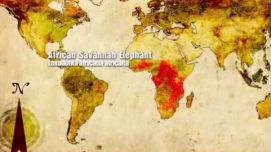African Bush Elephant
Loxodonta africana
The African Bush Elephant (Loxodonta africana) is the larger of the two species of African elephant. Both it and the African Forest Elephant have usually been classified as a single species, known simply as the African Elephant. (Some authorities still consider the currently available evidence insufficient for splitting the African Elephant into two species.) It is also known as the Bush Elephant or Savanna Elephant.
While the species is designated as vulnerable, conditions vary somewhat by region within Eastern and Southern Africa.
In 2006, an elephant slaughter was documented in southeastern Chad by aerial surveys. A series of poaching incidents, resulting in the killing of more than 100 elephants, was carried out during the late spring and summer of 2006 in the vicinity of Zakouma National Park. This region has a decades-old history of poaching of elephants, which has caused the elephant population of the region to drop from approximately 300,000 in 1970 to around 10,000 today. The African Bush Elephant officially is protected by Chadian government, but the resources and manpower provided by the government (with some European Union assistance) have proven insufficient to stop the poaching.
Human encroachment into or adjacent to natural areas where Bush Elephants occur has led to research of methods that safely drive groups of elephants away from humans, including the discovery that playback of the recorded sounds of angry honey bees are remarkably effective at prompting elephants to flee an area.
Related Topics
The African Bush Elephant (Loxodonta africana) is the larger of the two species of African elephant. Both it and the African Forest Elephant have usually been classified as a single species, known simply as the African Elephant. (Some authorities still consider the currently available evidence insufficient for splitting the African Elephant into two species.) It is also known as the Bush Elephant or Savanna Elephant.
While the species is designated as vulnerable, conditions vary somewhat by region within Eastern and Southern Africa.
In 2006, an elephant slaughter was documented in southeastern Chad by aerial surveys. A series of poaching incidents, resulting in the killing of more than 100 elephants, was carried out during the late spring and summer of 2006 in the vicinity of Zakouma National Park. This region has a decades-old history of poaching of elephants, which has caused the elephant population of the region to drop from approximately 300,000 in 1970 to around 10,000 today. The African Bush Elephant officially is protected by Chadian government, but the resources and manpower provided by the government (with some European Union assistance) have proven insufficient to stop the poaching.
Human encroachment into or adjacent to natural areas where Bush Elephants occur has led to research of methods that safely drive groups of elephants away from humans, including the discovery that playback of the recorded sounds of angry honey bees are remarkably effective at prompting elephants to flee an area.

































































































